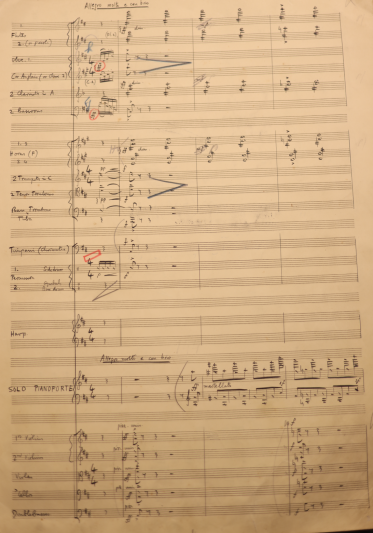In the latter part of the year 2019 the Cornwall Archives and Cornish Studies Service (Kresen Kernow) was offered, by private treaty, a number of archival items relating to the Cornish estate of the Earl of Kimberley in the Falmouth area.
Search FNL grants since 1931
The Chippendale Society is extremely grateful for the support of the Friends of the National Libraries, which has enabled it to add a group of previously unknown drawings to its collection. They were discovered in a collection of architectural drawings bearing the bookplate of Alexander Manning (1819-1903). Manning was an Irishman who arrived in Toronto in 1834. A carpenter by training, he became one of the most successful builders and property developers in the city.
A full purchase grant from FNL has secured for us a really fine copy of the 1929 first edition of Coleridge’s Ancient Mariner, with line engravings by David Jones. It was published by Douglas Cleverdon, who later became famous as a pioneering radio producer, responsible, most notably, for the production of Dylan Thomas’s radio play Under Milk Wood. This is a particularly appropriate acquisition, as Jones was for a long time a friend of Campion Hall, a small Jesuit College in Oxford, sending cards and small works of art, and advising on the decoration of the painted chapel. His artist’s proofs for the Ancient Mariner engravings came to us after his death, but we have never had a copy of the book until now.
A newly discovered book from the library of the Cambridge scholar and bibliophile Gabriel Harvey (1552/3–1631), extensively and engagingly annotated throughout, has recently been acquired by Cambridge University Library through the generosity of the Friends of the National Libraries. This polemical pamphlet on Catherine de Medici attracted enormous attention immediately upon its publication, its anonymous author clearly a witness in Paris to the political and religious upheavals that agitated the capital during the first half the 1570s. Modelled satirically on a saint’s life, the Discourse purports to expose the devious and perverse character of Catherine, which threatens to lead to the destruction of the French kingdom. At once an anti-Italian and misogynist assault on the Queen Mother, it represents one of the foundational texts behind the notorious image of Catherine as the Black Queen.
This exceptionally rare book of Orthodox liturgy and theology in Old Church Slavonic is an exciting addition to the collection of early Slavonic books found across collegiate Cambridge. It contains 31 chapters covering all aspects of the Orthodox tradition, including polemical treatises against heretics, Catholics, and traitors to the Orthodox faith. Much of the content is derived from the earlier writings of Zakhariia Kopystens’kyi, Archimandrite of the Kyiv-Pechersk Monastery, which discuss the state of religion and belief in Orthodox Eastern Europe, the differences between the Eastern and Western churches, the significance of icons, apostolic power, churches, the role of the Patriarch, and more. The publication was sanctioned by the Orthodox Church and printed by Stefan Boniface (Stefan Vonifat’ev), a prominent protopope.
This image of Brunel, in front of the giant chains used to control the launch of the massive SS Great Eastern, was to become one of the most important photographic images of the era, and of Brunel himself - one of the towering geniuses of the Victorian age.
At the time of this photograph, Isambard Kingdom Brunel was one of the most celebrated men of his age, known for landmark engineering projects such as the Great Western Railway, numerous bridges, tunnels, stations and dockyards, and ground-breaking steamships.
In childhood, Charlotte Brontë (1816-1855) and her siblings created a rich imaginary world, sparked by a set of toy soldiers given to Branwell by their father, and chronicled in tiny handwritten books. Their minute scale and miniature details such as title pages and advertisements, make these little books the most memorable and iconic items in the Museum’s collection. They also chart Charlotte Brontë’s development as a writer and reveal how many of her early themes carry over into her published novels.
In March 2020 the Britten-Pears Arts purchased the Archive of Lennox Berkeley Papers to form part of the Britten Pears Archive held at the Red House, Benjamin Britten’s home in Aldeburgh, Suffolk.
Comprising 17 boxes and 182 framed items together with some loose papers, the archive includes Peake’s illustrations for classic works of literature including Treasure Island, Household Tales by the Brothers Grimm, The Hunting of the Snark and Dr Jekyll and Mr Hyde, as well as illustrations for his own novels (including Gormenghast), children’s books, plays, poetry and television projects. Also included are drawings of famous literary, theatrical and artistic figures, among them Laurence Olivier and Peggy Ashcroft. The archive contains unpublished material and rough sketches that are key to understanding Peake’s artistic and literary development.
The archive forms a key source for British and international history in the 18th -20th centuries, and is closely related to manuscripts and archives in the Bodleian, particularly the extensive political collections.
The private papers of George William Frederick Villiers, 4th Earl of Clarendon (1800-1870) are at the heart of the archive. He was a leading statesman of the early Victorian era, as ambassador to Spain, 1833-9, Lord Privy Seal, 1840, President of the Board of Trade 1846-7, Lord Lieutenant of Ireland 1847-52, Foreign Secretary 1853-8, 1865-6 and 1868-70, and Chancellor of the Duchy of Lancaster from 1864-5. His postings coincided with key moments of the era such as the Irish Famine and the Crimean War. His official papers were deposited in the Bodleian in 1949, and transferred to the Bodleian's ownership by Acceptance in Lieu and purchase in 2012 with FNL’s support.





